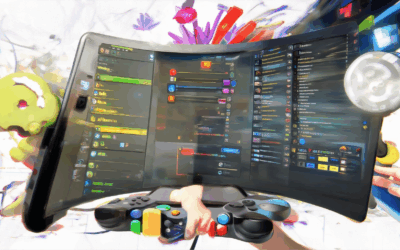In the dynamic world of gaming, the art of designing in-game rewards plays a pivotal role in captivating players and enhancing their overall experience. From boosting player retention to fostering engagement, effective in-game rewards design is a cornerstone of successful gameplay mechanics. This comprehensive guide delves into the intricate details of creating rewarding systems that resonate with players, exploring everything from strategic integration to core elements that drive success. By examining the principles behind effective design, leveraging technology, and staying ahead of future trends, this guide offers actionable insights for both seasoned designers and newcomers. Whether you’re aiming to enhance user experience or build a thriving community, understanding the nuances of in-game rewards design is key to unlocking player engagement and ensuring your game stands out in a competitive landscape.
Key Takeaways
– Personalized Progress Tracking boosts engagement by letting players see their progress.
– Reward Variety keeps players interested with diverse options like XP boosts and exclusive items.
– Tiered Reward Systems encourage long-term play by offering progressively better rewards.
– Timed Rewards heighten achievement feelings when delivered at pivotal moments.
– Theme-Aligned Rewards resonate deeper with players by matching the game’s environment.
– Analytics-Informed Decisions optimize reward structures based on player behavior.
– Balanced Rewards maintain interest by avoiding overwhelm or scarcity.
– Effort-Based Satisfaction reinforces the link between player actions and positive outcomes.
– Alignment of Effort and Reward builds trust and motivation.
– Types of Rewards cater to different preferences with badges, currency, and customization.
– Emotional Connections deepen via personalized rewards and meaningful progression.
– Reward Variety prevents boredom with rotating events and tiered systems.
– Feedback Loops drive engagement through positive reinforcement and iterative improvements.
– Player Behavior Analysis informs reward designs for optimal effectiveness.
– Clear Motivation aligns rewards with player goals and inherent interests.

How Can In-Game Rewards Design Help Keep Players Engaged?
In-game rewards design plays a crucial role in keeping players engaged by creating a sense of progression, satisfaction, and motivation. Here’s how it can effectively enhance player engagement:
- Progression and Achievement:** By rewarding players with unlockable content, badges, or milestones, games create a clear path toward growth. This fosters a sense of accomplishment and encourages continued play.
- Motivation and Incentive:** Well-designed rewards systems provide a reason to keep playing. Whether it’s earning in-game currency, leveling up, or unlocking exclusive features, rewards keep the gameplay experience fresh and exciting.
- Encouragement of Regular Play:** Regular rewards, such as daily login bonuses or consistent progress updates, reinforce the habit of returning to the game. This consistency helps build long-term engagement.
- Personalization and Customization:** Allowing players to earn and apply customizations to their avatars, characters, or gear adds a personal touch. This makes the rewards feel more meaningful and increases attachment to the game world.
- Community and Social Interaction:** In some cases, rewards can be shared or compared within a community, fostering social connections and competition among players. This can lead to increased word-of-mouth marketing and community growth.
By thoughtfully designing reward systems, developers can create a more immersive and enjoyable experience that keeps players coming back again and again. For more insights on optimizing your game’s reward system, explore our tutorial on reward systems and discover how to balance incentives to maximize player engagement.
The Key Elements of Effective In-Game Rewards Design
The design of in-game rewards plays a crucial role in enhancing player engagement and retention. To create an effective reward system, consider the following essential elements:
- Alignment with Game Theme and Mechanics
- Ensure rewards align with the game’s theme, style, and core mechanics. Players appreciate consistency between visual design, gameplay, and reward systems.
- Example: In a fantasy RPG, rewards like gold coins, magical artifacts, or experience points should reflect the game’s aesthetic and objectives.
-
Variety and Temptation
- Offer diverse reward types to cater to different player preferences. Regular updates and seasonal events keep the reward system fresh and exciting.
- Example: Provide daily login bonuses, achievement unlocks, or exclusive cosmetic items that players cannot obtain elsewhere.
-
Balance and Value
- Maintain equilibrium between the quantity and quality of rewards. Overabundance can devalue rewards, while scarcity enhances desirability.
- Example: Implement tiered reward systems where higher achievements unlock premium content, fostering progression and investment in the game.
-
Catering to Player Motivations
- Understand intrinsic and extrinsic motivators. Reward systems should leverage achievements, social interactions, and personal growth.
- Example: Leaderboards, community challenges, or personalized milestones can boost player engagement and competition.
-
Consistency and Predictability
- Establish clear patterns in reward distribution to build trust and anticipation. Regular updates keep players invested in the game’s economy.
- Example: Daily rewards, weekly events, and consistent loot crate mechanisms create predictable yet exciting experiences.
-
Testing and Iteration
- Continuously gather player feedback through surveys, forums, and analytics. Adjust reward structures based on performance metrics and player behavior.
- Example: A/B testing different reward configurations can optimize effectiveness and satisfaction levels.
By thoughtfully integrating these elements, you can create a reward system that not only boosts player engagement but also strengthens game loyalty and monetization potential. For further insights and resources, explore our tutorial on reward system design and join our developer community for discussions and best practices.

How Does Effective In-Game Rewards Design Improve Player Experience?
Effective in-game rewards design significantly enhances player experience by creating deeper engagement, increasing motivation, and boosting overall satisfaction. Here’s how it achieves this:
- Immersion and Motivation :
- Well-designed rewards keep players invested in the game by giving them a sense of progression and accomplishment.
- By aligning rewards with in-game achievements, such as unlocking new levels, skills, or exclusive content, players feel motivated to continue playing.
- Achievements and badges further reinforce this progress, creating a positive emotional connection to the game.
- Increased Satisfaction :
- Thoughtful reward systems satisfy players’ needs for recognition and reward, which are fundamental human motivations.
- Customizable rewards, such as personalized gear or unique cosmetic items, allow players to express their identity within the game.
- Regular, fair rewards encourage consistent play, ensuring players return for new challenges and opportunities.
- Enhanced Gameplay Experience :
- Properly integrated rewards complement the game’s core mechanics, making gameplay more enjoyable and rewarding.
- For example, loot crates or mystery boxes add excitement without overwhelming players, maintaining balance.
- Seasonal events and limited-time offers create urgency, driving players to participate actively.
- Competitor Analysis and Best Practices :
- Platforms like Unity and Unreal Engine offer robust reward systems that inspire creativity in game design.
- Services like Playcraft and GameSalads provide tools for developers to implement effective reward mechanisms seamlessly.
- By studying successful games, developers can refine their own reward structures to maximize player engagement.
By focusing on these elements, developers can create meaningful rewards that resonate with players, leading to higher retention rates and a more fulfilling gaming experience.

How to Design Effective In-Game Rewards
To design effective in-game rewards, consider the following structured approach:
- Personalized Progress Tracking : Implement a system where players can view their individual progress, allowing rewards to feel customized and meaningful.
- Reward Variety : Offer diverse reward types such as XP boosts, exclusive items, or unique abilities to keep the experience fresh and engaging.
- Tiered Reward System : Introduce progression tiers where players unlock progressively better rewards, encouraging continued play and investment in their characters.
- Timed Rewards : Deliver rewards at pivotal moments, such as defeating a boss or completing a challenging level, to heighten the sense of achievement.
- Theme-Aligned Rewards : Create rewards that resonate with the game’s theme, whether it’s high-tech items in a sci-fi game or magical artifacts in a fantasy setting.
- Analytics-Informed Decisions : Use player data to identify popular reward types and test different configurations to optimize effectiveness.
- Balance and Value : Ensure rewards are neither too abundant nor scarce, maintaining a balance that enhances gameplay without overwhelming players.
- Effort-Based Satisfaction : Design rewards that feel earned through dedication, reinforcing the connection between player actions and positive outcomes.
By integrating these strategies, you can create a reward system that enhances player engagement and immersion, driving sustained interest in your game.
What Does an Expert In-Game Rewards Designer Focus On During Their Design Process?
An expert in-game rewards designer focuses on creating engaging experiences by balancing motivation, ensuring rewards align with player goals, fostering emotional connections, and maintaining variety to keep players invested. Here’s a breakdown of their key priorities:
- Alignment of Effort and Reward : Designers ensure that the time, skill, and persistence players invest are matched with proportional rewards. This builds trust and keeps players motivated.
- Types of Rewards : They implement a mix of intrinsic (e.g., achievement badges) and extrinsic rewards (e.g., in-game currency) tailored to player preferences. This includes designing progression systems, character customization options, and collectible items.
- Emotional Connection : Personalized rewards and meaningful progression help players feel their journey is unique and valuable. This fosters attachment, reducing churn rates.
- Reward Variety : To prevent boredom, designers introduce rotating events, seasonal challenges, and tiered reward systems. This ensures the reward structure remains fresh and exciting.
- Feedback Loops : Positive reinforcement is key. Players feel accomplished when they earn rewards, encouraging continued engagement. Negative feedback, like temporary loss of rewards, motivates players to improve.
- Player Behavior Analysis : Experts study player behavior to understand what drives engagement. They test reward structures, iterate based on feedback, and use analytics tools to track effectiveness.
By focusing on these elements, in-game rewards designers ensure players stay engaged, motivated, and satisfied with their gaming experience.

Key Principles Behind Effective In-Game Rewards Design
The design of in-game rewards plays a crucial role in keeping players engaged and motivated. Here are the essential principles that guide successful reward systems in gaming:
1. Balance
Rewards must be balanced to maintain player interest. This balance ensures that players feel neither overwhelmed nor underwhelmed. A well-designed reward system offers attainable goals while still presenting a challenge.
Attainability
Rewards should be accessible but not too easy. Players want to feel a sense of achievement when they earn a reward, which encourages them to continue playing.
Progression Systems
A reward system should support long-term engagement. Clear progression paths, such as leveling up or unlocking new abilities, help players visualize their goals and stay motivated.
2. Variety
Offering diverse reward types caters to different player preferences. This variety keeps the gameplay fresh and exciting.
Multiple Reward Types
Combine different reward mechanisms, such as currency, collectibles, and experiences, to appeal to various playstyles.
Regular Updates
Keep the reward system dynamic by regularly introducing new items or events. This ensures players always have something new to aim for.
3. Consistency
Consistency builds trust and enhances the overall gaming experience. Players expect rewards to align with their efforts.
Predictable Patterns
Establish clear patterns in reward distribution to help players understand what to expect. This predictability fosters a sense of reliability.
Clear Feedback
Immediately reward actions with visible feedback, such as in-game messages or sounds, to reinforce positive behavior.
4. Personalization
Personalized rewards enhance the emotional connection players feel with the game.
Customizable Options
Allow players to choose or customize their rewards, making the experience more individualized and enjoyable.
Dynamic Adjustments
Adapt rewards based on player performance and preferences to maximize satisfaction.
5. Clear Motivation
Effective rewards are driven by a deep understanding of player motivations.
Intrinsic Motivation
Align rewards with activities that players find inherently rewarding, such as exploration or social interaction.
Ex extrinsic Motivation
Use rewards to encourage specific behaviors, ensuring they contribute positively to the game’s objectives.
6. Feedback Loop
A well-designed reward system creates a positive feedback loop that drives continuous engagement.
Positive Reinforcement
Reward actions that contribute to the game’s success, encouraging players to repeat those behaviors.
Iterative Improvement
Use player feedback to continuously refine rewards and mechanics, ensuring they remain effective and enjoyable.
Conclusion
By balancing variety, consistency, personalization, and motivation, game designers can create reward systems that resonate deeply with players. These principles not only enhance the gaming experience but also foster long-term engagement and satisfaction.




0 Comments